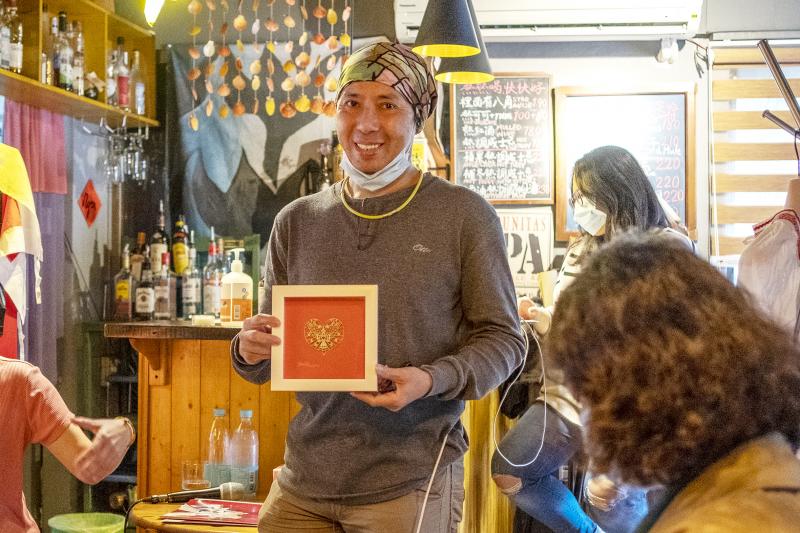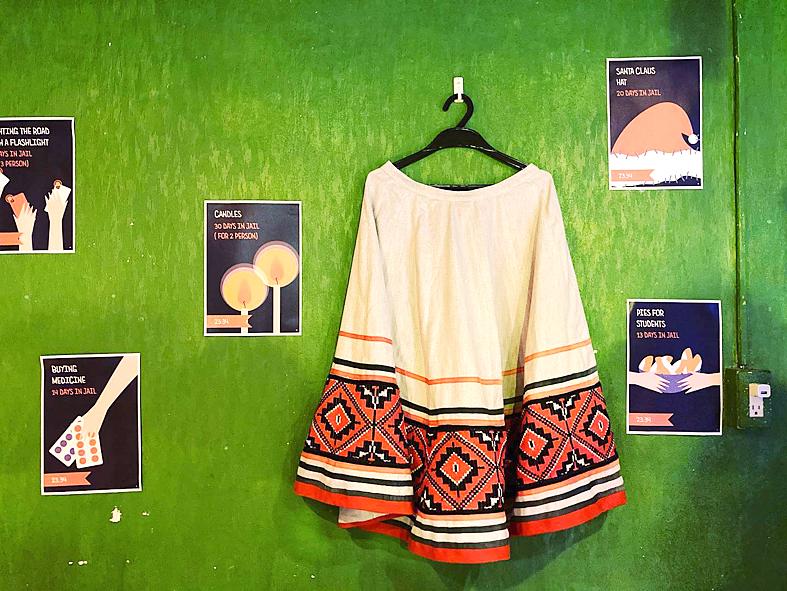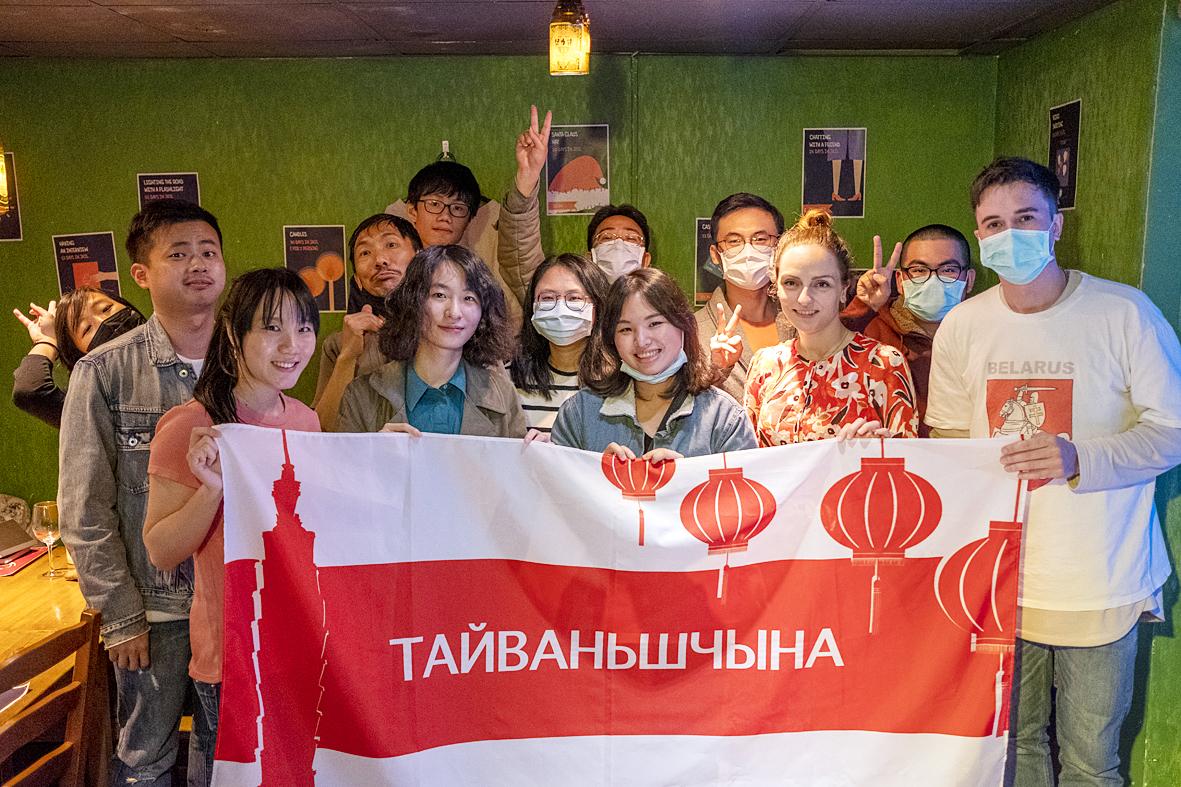Anastasia Kurlenia recoils in mock horror. Her daughter Sophie has broached the unthinkable.
“Those are the Russian colors,” says the six-year-old, pointing at the red and white of the flags and traditional attire on the walls of Liuminzhan Bar & Bed, a cosy cafe on a backstreet in New Taipei’s Yonghe District (永和).
“Just kidding,” she responds to her mother’s goggle-eyed gape. “I know it’s Belarus.”

Photo courtesy of Lin Yen Ting
For an event focusing on a rigged election and violent crackdown against dissent, things are off to a light-hearted start. But this is the Belarusian way. Despite the gravity of the topic, the presentation delivered by Kurlenia and her compatriot Artem Subotka over the next three hours frequently embraces gallows humor. The event, which was held on Feb. 6 and titled Razam, meaning “together,” was designed to show solidarity with Belarusians protesting the re-election of Alexander Lukashenko as president on Aug. 9 last year. The result was almost universally derided as a sham.
At one point, Subotka recounts a joke about a Russian, a Ukrainian and a Belarusian who are to be hanged during World War II. The format and set-up are similar to an old “Englishman, Irishman, Scotsman,” gag, the diverging punchline emphasizing the Belarusian’s stoicism.
“The Russian is hanged first and fights against the rope for 10 seconds,” says Artem. “The Ukrainian fights for 30 seconds,” he adds. “Finally, the Belarusian is hanged, but he just hangs and hangs. ‘Why aren’t you dying?’ they ask. ‘Oh, I don’t know,’ he says. ‘I was just hanging here and finally it became all right.’”

Photo courtesy of Lin Yen Ting
Another wisecrack from Artem involves the colors of the current flag, a wide horizontal bar of red above a narrower bar of green, essentially the Soviet era design minus the sickle. The flag was adopted by “Europe’s last dictator” Lukashenko in 1995 and slightly adjusted in 2012.
“We say it represents a red sun setting over a green swamp,” says Subotka, a 31-year-old teacher, who has lived in Taiwan for five years and, like Kurlenia, is married to a Taiwanese.
A NEW BELARUSIAN

Photo courtesy of Lin Yen Ting
Weary resignation has long been considered a Belarusian characteristic. Yet following the election, a new Belarusian emerged. The latest election charade proved a tipping point. Passive acceptance gave way to indignation.
“In previous elections, you knew your friends voted against [Lukashenko], but you didn’t really understand how many people had,” says Kurlenia, a 34-year-old entrepreneur who arrived in Taiwan as a master’s degree student at National Taiwan University seven years ago. “But this time was different. Your friends, your neighbors, the guys nearby …”
“Everyone,” Subotka interjects. “Maybe one in a hundred voted for Lukashenko.”
The flagrancy of the fraud — Kurlenia calls it “super obvious” — galvanized people.
“People could not accept this anymore,” Kurlenia says.
Things got worse as the already draconian article 23.34 of the Belarusian Code of Administrative Offenses was given even looser application. Posters on the wall of Liuminzhan Bar & Bed reveal charges brought for “offenses” include eating kebabs in public. Arbitrary arrest and torture became commonplace, and Subotka describes the detainment and beating of relatives, two of whom fled the country.
Despite outrage over these excesses, the protesters remained peaceful.
“Although violence might be more effective, Belarusians are not violent people,” says Kurlenia. “It’s different from what we saw in Ukraine,” she adds, referring to the 2013-2014 Euromaidan protests that culminated in the ouster of former president Viktor Yanukovych.
CULTURAL SIMILARITIES
For Liao Yun-jie (廖芸婕), a journalist who moderated the Razam event, this display of reserve was unsurprising. During a visit to the country in 2014, she noticed similarities between Belarusians and Taiwanese.
“People’s ideas of freedom, identity and homeland felt very much related to Taiwan,” Liao says.
In the images of Belarusian demonstrators removing their shoes before standing on park benches, she saw parallels with Taiwanese activists cleaning up after rallies.
“There is debate over whether Taiwanese are too polite during protests,” Liao says, before asking whether a comparable dilemma over the appropriate strategy has arisen in Belarus.
Subotka thinks not, arguing that a violent response would spark further reprisals and perhaps provide a pretext for Russian intervention.
“We push our people to do it the right way so we can document it, make it legal and have power in the law,” Subotka says.
Having to operate on the fringes of legality has engendered a creative response, and the event spotlights this. Using the red-and-white of the short-lived Belarusian Democratic Republic of 1918, which was revived between 1991-1995 following independence from Soviet rule, a series of provocative artworks has been created.
As the flag was also used during the Nazi occupation, Lukashenko has attempted to smear the protesters as fascists to justify the crackdown. Under 34:43, public displays of the colors — including scarves, candy and even Santa hats — have led to arrests. Yet, the protesters have used inventive means to subvert these restrictions.
CREATIVE DISSIDENCE
Slides are shown of a bra and underwear hung on a balcony, strategically positioned to replicate the white-red-white pattern.
“People are just trying to find different ways to protest,” says Subotka. “It’s an example of Belarusian creativity,” Kurlenia adds.
Having petitioned Taiwan’s government for a statement of solidarity and received a stock answer, Kurlenia believes that cooperation through non-official channels — education, sport and technology — is the logical next step. Future activities are planned to raise awareness in Taiwan. Long-term, Subotka is optimistic that Sviatlana Tsikhanouskaya — the opposition candidate who is widely perceived as having won the election — would establish ties with Taiwan.
“When she gets in power, she’ll probably favor Taiwan,” he says. “China has openly crushed human rights, so it’s not our friend.”

On April 26, The Lancet published a letter from two doctors at Taichung-based China Medical University Hospital (CMUH) warning that “Taiwan’s Health Care System is on the Brink of Collapse.” The authors said that “Years of policy inaction and mismanagement of resources have led to the National Health Insurance system operating under unsustainable conditions.” The pushback was immediate. Errors in the paper were quickly identified and publicized, to discredit the authors (the hospital apologized). CNA reported that CMUH said the letter described Taiwan in 2021 as having 62 nurses per 10,000 people, when the correct number was 78 nurses per 10,000

As Donald Trump’s executive order in March led to the shuttering of Voice of America (VOA) — the global broadcaster whose roots date back to the fight against Nazi propaganda — he quickly attracted support from figures not used to aligning themselves with any US administration. Trump had ordered the US Agency for Global Media, the federal agency that funds VOA and other groups promoting independent journalism overseas, to be “eliminated to the maximum extent consistent with applicable law.” The decision suddenly halted programming in 49 languages to more than 425 million people. In Moscow, Margarita Simonyan, the hardline editor-in-chief of the

Six weeks before I embarked on a research mission in Kyoto, I was sitting alone at a bar counter in Melbourne. Next to me, a woman was bragging loudly to a friend: She, too, was heading to Kyoto, I quickly discerned. Except her trip was in four months. And she’d just pulled an all-nighter booking restaurant reservations. As I snooped on the conversation, I broke out in a sweat, panicking because I’d yet to secure a single table. Then I remembered: Eating well in Japan is absolutely not something to lose sleep over. It’s true that the best-known institutions book up faster

Though the total area of Penghu isn’t that large, exploring all of it — including its numerous outlying islands — could easily take a couple of weeks. The most remote township accessible by road from Magong City (馬公市) is Siyu (西嶼鄉), and this place alone deserves at least two days to fully appreciate. Whether it’s beaches, architecture, museums, snacks, sunrises or sunsets that attract you, Siyu has something for everyone. Though only 5km from Magong by sea, no ferry service currently exists and it must be reached by a long circuitous route around the main island of Penghu, with the